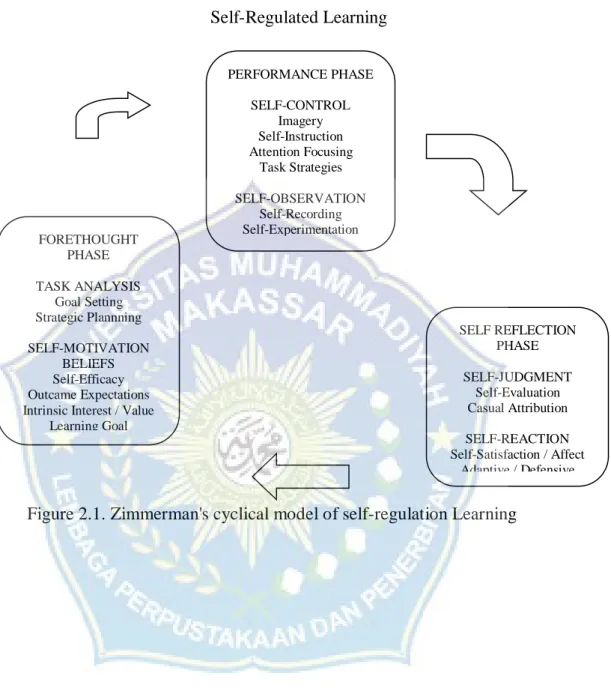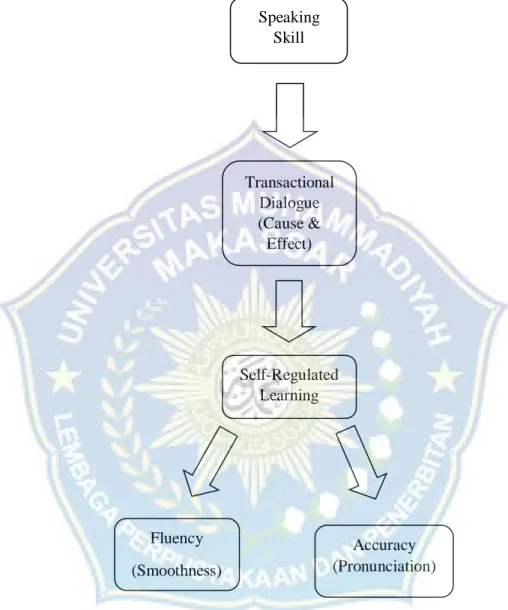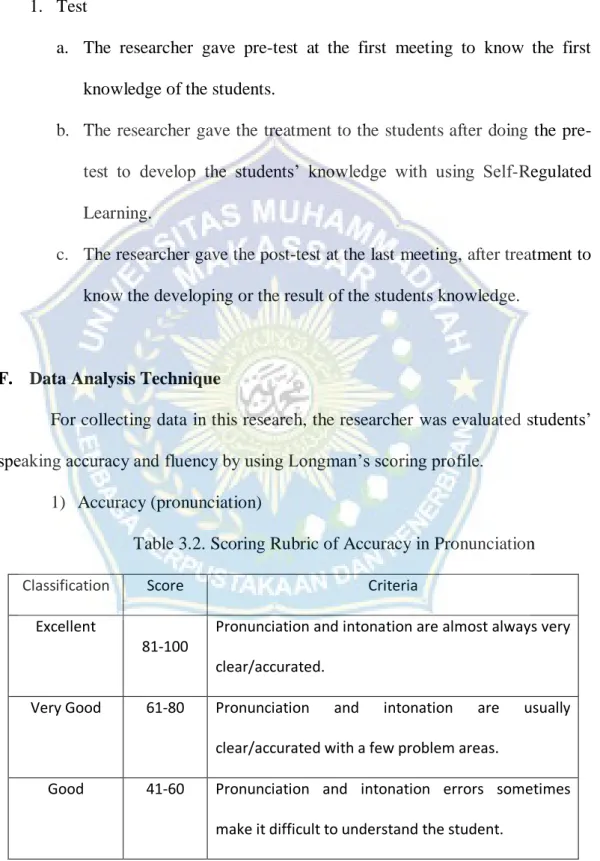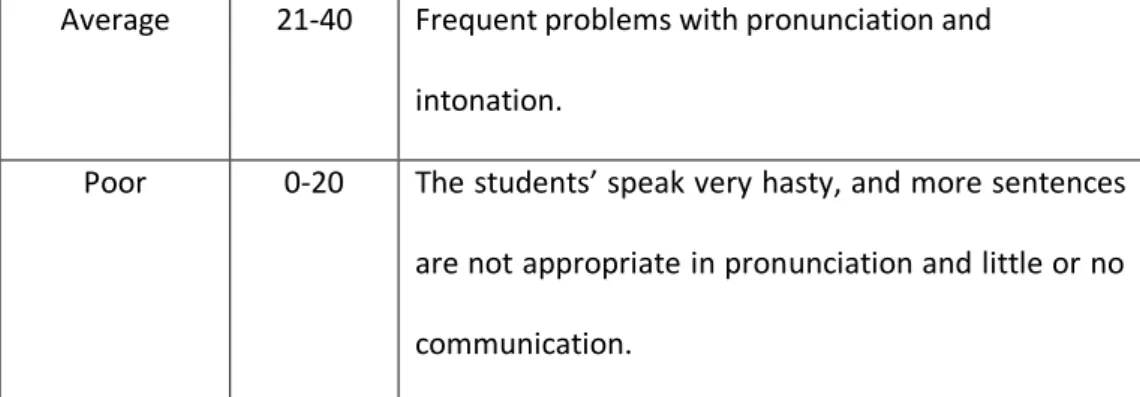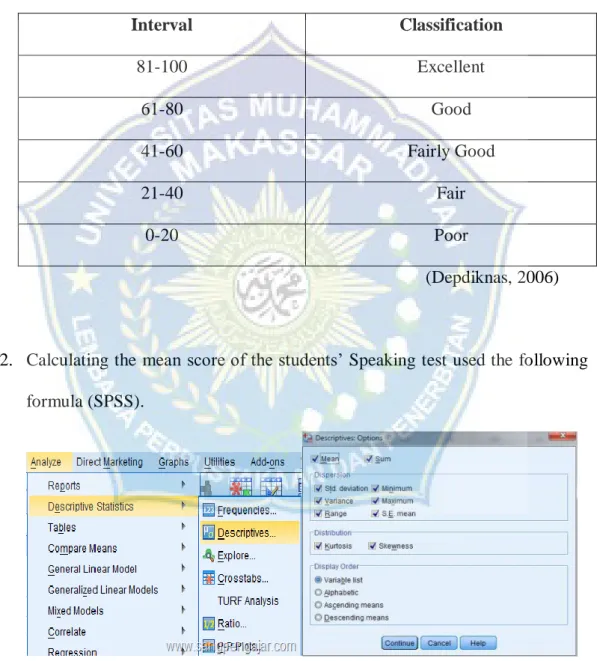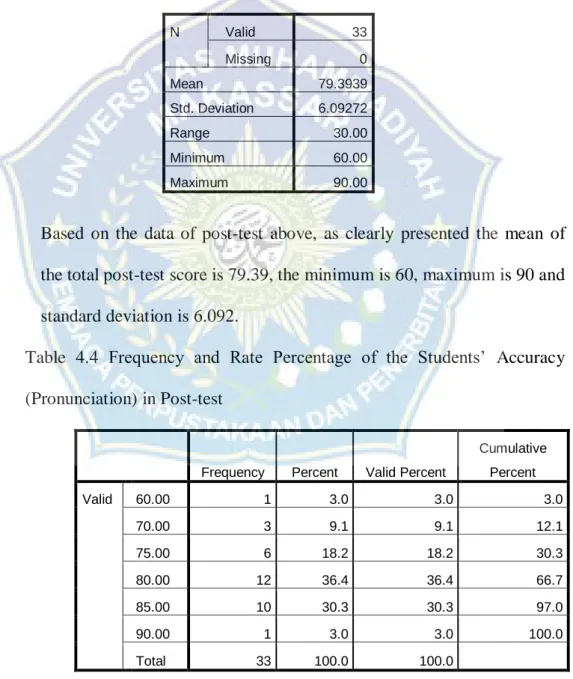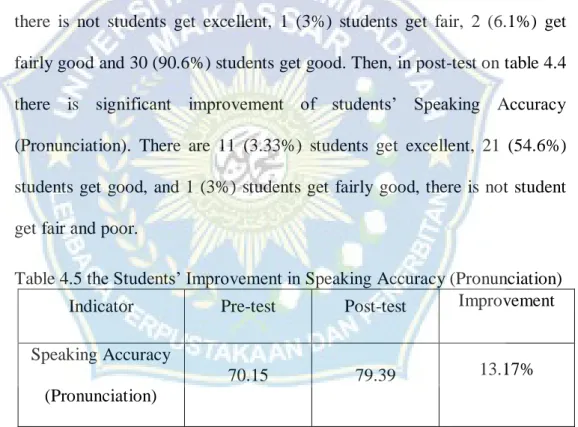Alhamdulilah, the researcher thanks you very much for thanking Allah. for the blessing and mercy to the researcher during the processing until the completion of the thesis. In writing this thesis, the researcher faces many difficulties, so the researcher realizes that the thesis has many mistakes and weaknesses. The researcher would like to say many thanks to the people who give encouragement, advice, suggestions and help.
The researcher realized that many people had given their help and helpful suggestions for the completion of this thesis.
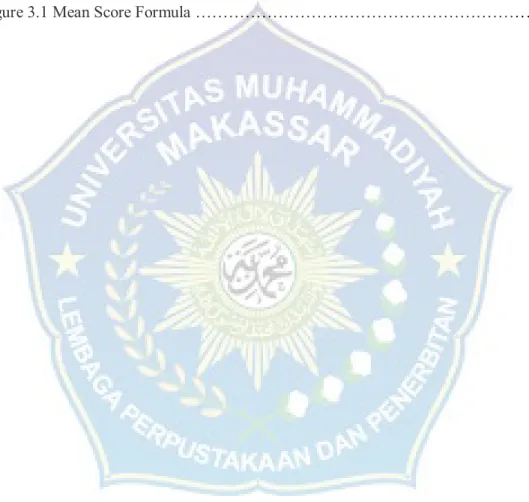
INTRODUCTION
- Background
- Problem of the Research
- Objective of the Research
- Significance of the Research
- Scope of the Research
Because if some of the students use English in their environment, there are some students who mock them. The teacher must know how much the ability of the students limits before he decides the method to the students. Not only to develop character education, Curriculum 2013 also tries to develop the students' competence.
Self-regulated learning gives students independence in the learning process, but of course with control from the teacher.
REVIEW OF RELATED LITERATURE
Previous Related Findings
It is clear that improving self-regulated learning in spoken communication class facilitates the development of students' speaking performance. In the same vein, self-regulated learning intervention in spoken communication class helps students to develop their speaking efficiency. Based on previous research above, the researcher was interested in conducting this research using self-regulated learning.
The similarities of this research and those researches were the use of self-regulated learning method to improve students' English skills.
Pertinent Ideas
Yet Cameron states in Permanasari that speech is the active use of language to express meanings so that other people can understand them. While, according to Flutcher in Permanasari speech is the verbal use of language to communicate with others" Furthermore, Mackey in Bygate in Permanasari speech summarized the oral expression as follows: "Oral expression involves not only the use of the right sounds in the right rhythm - and intonation patterns, but also choosing words and inflections in the right order to convey the right meaning.”. Pronunciation is the production of speech sound for communication and it is very important in communication.
Fluency is the ability to speak English through a good grouping and reduces form (Brown in Asmayanti & Amalia 2014).
Teaching Speaking
Self-Regulated Learning
And also Lado in Flutcher in Permanasari (2014:1) wrote: "The ability to speak a foreign language is undoubtedly the most valuable language skills and rightly so." It means speaking has the main role in English also to communicate with each other. Based on the goals of the 2013 curriculum and the entire problem above, the researcher decides to use self-regulated learning to develop speaking skills. Does the self-regulated learning method develop the speaking accuracy (pronunciation) of students in the eleventh grade of SMAN 5 Barru.
Does the self-regulated learning method develop the speaking skills (fluency) of students in the eleventh grade of SMAN 5 Barru? This research will provide the teachers with a new topic or insight and reflection on the use of the self-regulated learning method to develop speaking skills. Self-regulated learning gave the students motivation and effort to improve their own skills, and of course with the teacher supporting them in monitoring the students' activities.
Conceptual Framework
Self-regulated learning plays a role in how students can understand, obtain or explain the material in their own way, and it trains students to learn independently.
Hypothesis
RESEARCH METHOD
- Research Design
- Population & Sample
- Research Variable
- Research Instrument
- Data Collection Procedure
- Data Analysis Technique
The purpose of the post-test was to know the significance of students' fluency (smoothness) and accuracy (pronunciation) in speaking ability. The researcher gave the treatment to the students after they did the pre-test to develop the students' knowledge of using Self-Regulated Learning. It presented the result of the students' Accuracy (Pronunciation) and Fluency (Smoothness) in speaking skill using self-regulated learning.
The purpose of this research is to find out if there are significant differences in the students' Accuracy (Pronunciation) and Fluency (Smoothness) in Speaking by using self-regulated learning. Then, in the post-test on table 4.4, there is significant improvement in students' Speaking Accuracy (Pronunciation). Then, in the post-test on table 4.10 there is a significant improvement in students' speaking fluency (Smoothness).
It is supported by the average score and percentage of pre-test and post-test score of the students. Therefore, Self-Regulated Learning is able to improve students' speaking ability in the eleventh grade students of SMAN 5 Barru. The use of self-regulated learning can develop students' speaking accuracy (pronunciation) in the eleventh grade of SMAN 5 Barru.
This demonstrates the improvement in students' mean score from pretest to posttest. The use of self-regulated learning can develop students' speaking fluency (fluency) in eleventh grade SMAN 5 Barru.
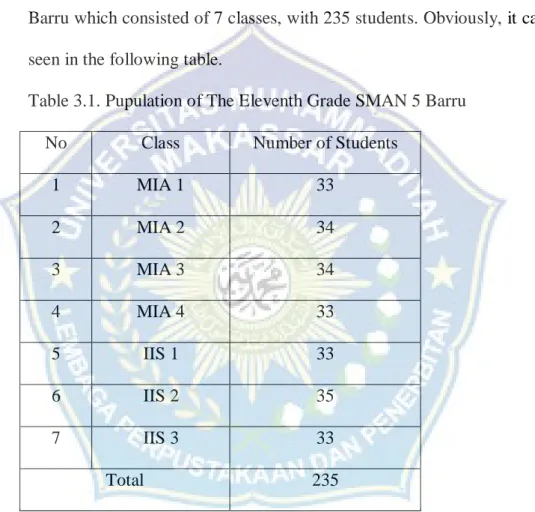
FINDINGS & DISCUSSION
Findings
The result of data findings find that the teaching of Speaking through Self-Regulated Learning can improve the students' Accuracy (Pronunciation) and Fluency (Smoothness), XI MIA 1 students of SMAN 5 Barru. Based on the data of Pretest, as clearly stated, the mean of the total pretest score is 70.15, the minimum is 40, maximum is 75 and standard deviation is 6.55. Finally, before the treatment, the students in the eleventh grade of SMAN 5 Barru have good speaking ability, especially accuracy (pronunciation).
Based on the data from posttest above, as clearly stated, the mean of the total posttest score is 79.39, the minimum is 60, maximum is 90 and standard deviation is 6.092. Speaking Accuracy (Pronunciation) in the post-test of 33 students, as presented in the table, almost all the students are in good category with 21 students or 54.6%. Based on the data of pretest, as clearly stated, the mean of the total pretest score is 71.66, the minimum is 50, maximum is 75 and standard deviation is 4.94.
In conclusion, before the treatment, the eleventh grade students in SMAN 5 Barru have good speaking abilities, especially fluency (smoothness). Based on the data from the post-test above, as clearly presented, the mean of the total post-test score is 81.06, the minimum is 60, the maximum is 90 and the standard deviation is 5.830. To know the significance level of the pre- and post-test from Accuracy (Pronunciation) and Fluency (Smoothness), the researcher uses the program SPSS 22 to analyze the T-test and T-table.
Note: PretestA = Pre-Test of Accuracy (Pronunciation) PosttestA = Post-Test of Accuracy (Pronunciation) PretestF = Pre-Test of Fluency (Fluency) PretestF = Post-Test of Fluency (Fluency). It means that there are significant differences between the results of the pre- and post-test in terms of speaking skills, especially accuracy (pronunciation) and fluency (fluency).
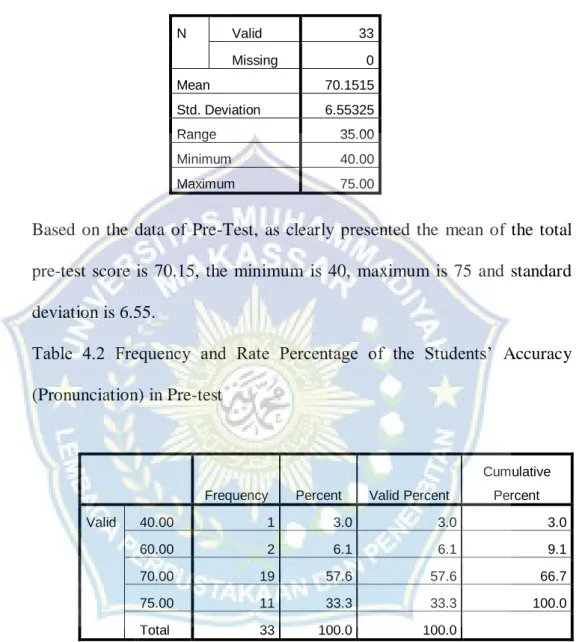
Discussion
It means that what students should pay attention to the sound of speech in speech. It means that the null hypothesis (H0) is rejected and the alternative hypothesis (H1) is accepted because there are significant differences of the mean test scores given by the researcher before and after the researcher using self-regulated learning in teaching speaking skill. From the above discussion, it can be concluded that the use of self-regulated learning is one of the teaching methods that can improve the speaking ability of students in the eleventh grade of SMAN 5 Barru.
Other researchers should be creative and innovative to change the technique activities in using self-regulated learning to improve students' speaking ability. Enhancing self-regulated learning in the teaching of spoken communication: Does it affect speaking efficiency and effectiveness?. Improving students' speaking skill through group research technique of seventh grade students of Mts Sudirman Jambu Semarang in academic year 2016/2017.
The implementation of self-regulated learning model using ICT media for the students' performance in introduction to accounting course. The use of self-regulated strategy development to improve the second degree students' writing ability on analytical exposition at MAN 3 Blitar. The effectiveness of using strip stories technique in teaching speaking to students' speaking performance of the eleventh grade students of excellent science class in MAN Tulungagung 1.
The correlation between self-concept and students' English speaking ability in the fifth semester students of Makassar Muhammadiyah University in the academic year 2014-2015. Data analysis of students' mean pre-test and post-test scores Note: Pre-test A = Pre-test accuracy (pronunciation).
CONCLUSION & SUGGESTION
Conclusion
Although the post-test is higher than the pre-test average score, the post-test accuracy (pronunciation) is 79.39. Although the post-test is higher than the pre-test average score, the post-test fluency (fluidity) is 81.06.
Suggestion
Type of Speaking Classroom Performance, (online), (http://ummykhoirunisya.blogspot.com/2014/07/types-of-classroom-. speaking-performance.html, diakses 10 november 2019). De componenten van spreekvaardigheid, (online), (https://adeprimarora.wordpress.com the-components-of-speaker-skill/, diakses pada 10 november 2019). Type of Speaking Classroom Performance, (online), (http://sintasriwahyuningsih.blogspot.com/2014/07/type-of-classroom-speaker-performance.html, diakses 10 november 2019).
Dengarkan dan tiru berbagai contoh interaksi terkait identitas dan hubungan keluarga, dengan pengucapan dan tekanan kata yang benar. Mendengarkan dan menirukan beberapa contoh percakapan sayap (terentang) yang diperagakan diberi ucapan selamat dan pujian. guru/rekaman, dengan pengucapan dan tekanan kata yang benar. Menyusun teks interaksi transaksional lisan dan tertulis pendek dan sederhana yang melibatkan pemberian dan permintaan informasi terkait maksud untuk melakukan suatu tindakan/aktivitas. dengan memperhatikan fungsi sosial, struktur teks, dan unsur kebahasaan yang benar dan sesuai konteks. unsur kebahasaan berbagai teks tertulis dan deskriptif dengan memberi dan meminta informasi tentang tempat wisata dan bangunan bersejarah yang terkenal.
Menempelkan teks tersebut di dinding kelas dan bertanya serta menjawab pertanyaan bersama pembaca (siswa lain, guru) yang datang untuk membacanya - Renungkan. untuk proses dan hasil pembelajaran. Mendengarkan dan menirukan guru membacakan beberapa teks pengumuman dengan intonasi, pengucapan dan tekanan kata yang benar. Membuat teks khusus berupa pengumuman (announcement), lisan dan tulisan, pendek dan sederhana. memperhatikan fungsi sosial, struktur teks, dan unsur kebahasaan secara benar dan sesuai konteks. mendorong perilaku yang mengandung KI.
